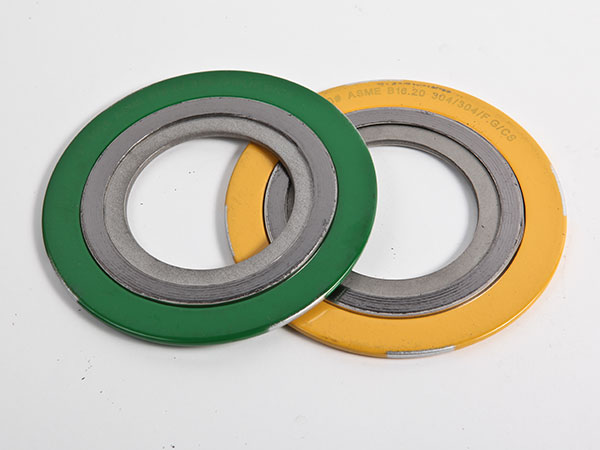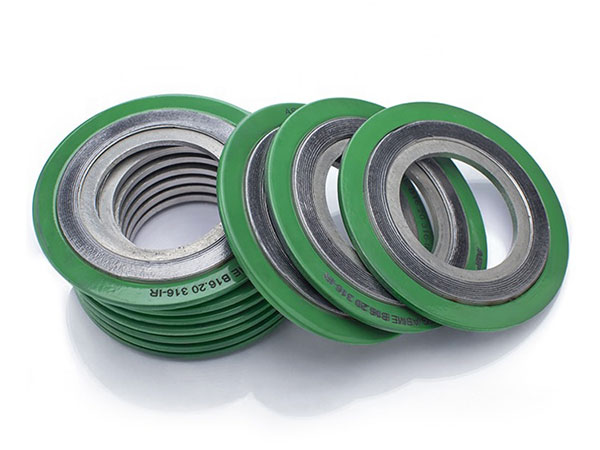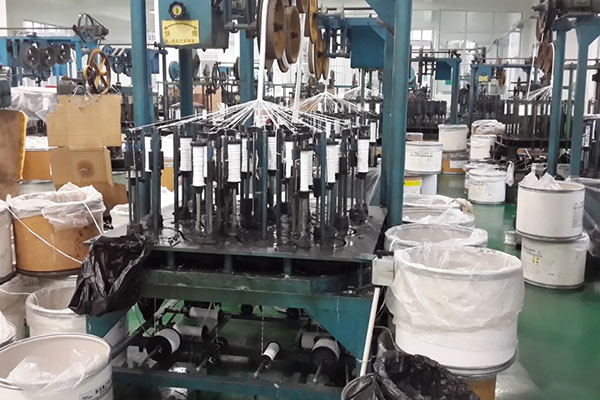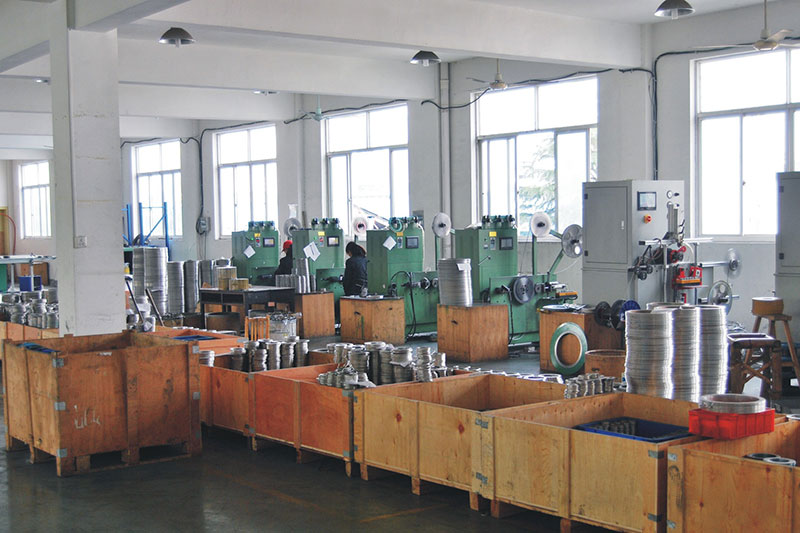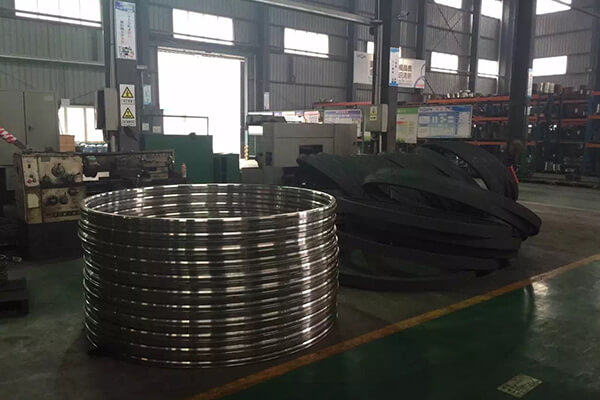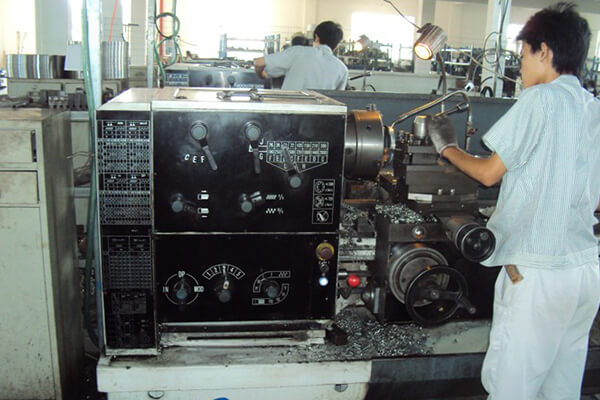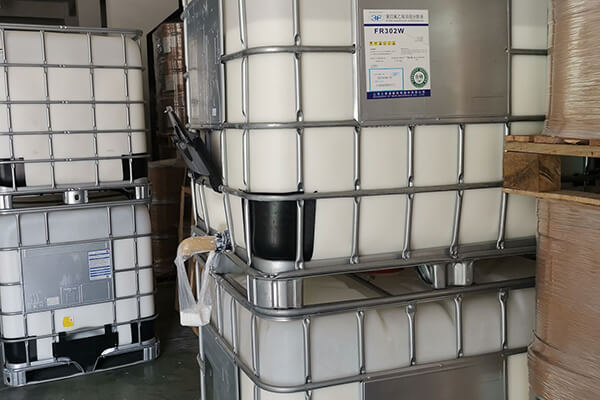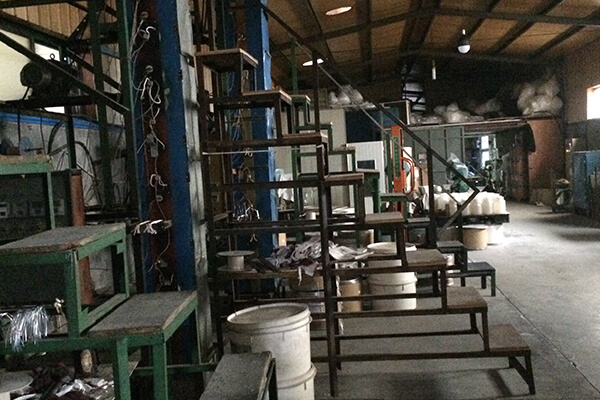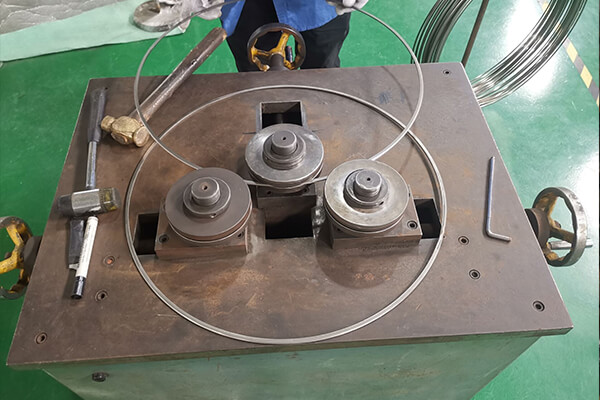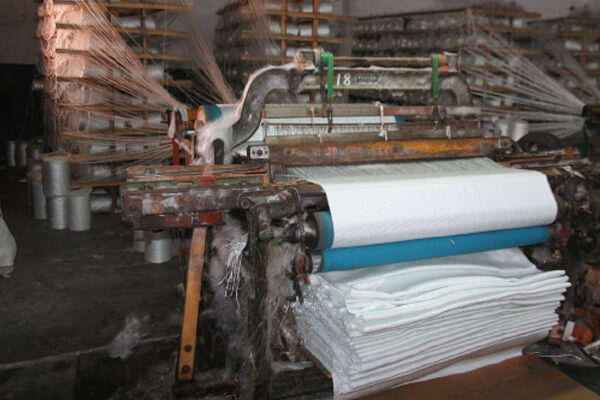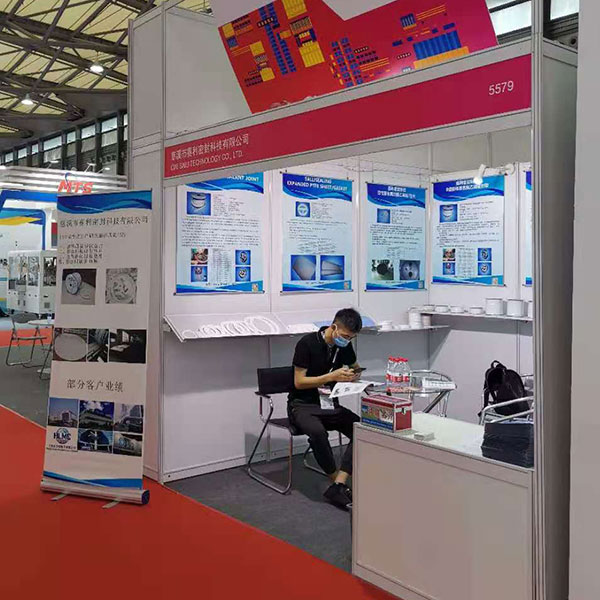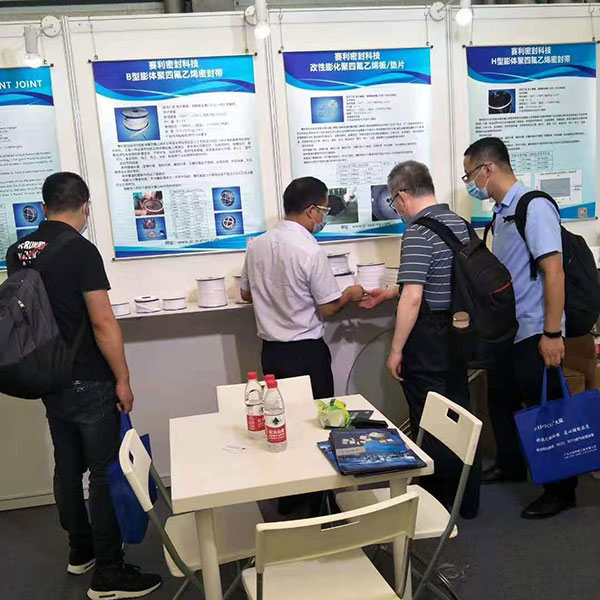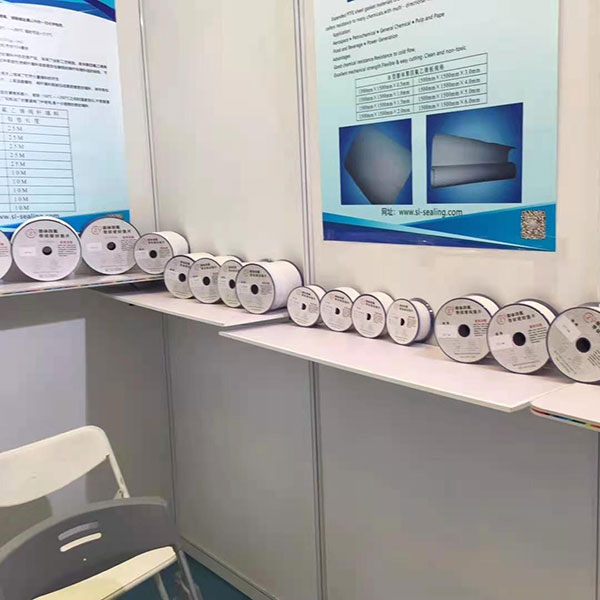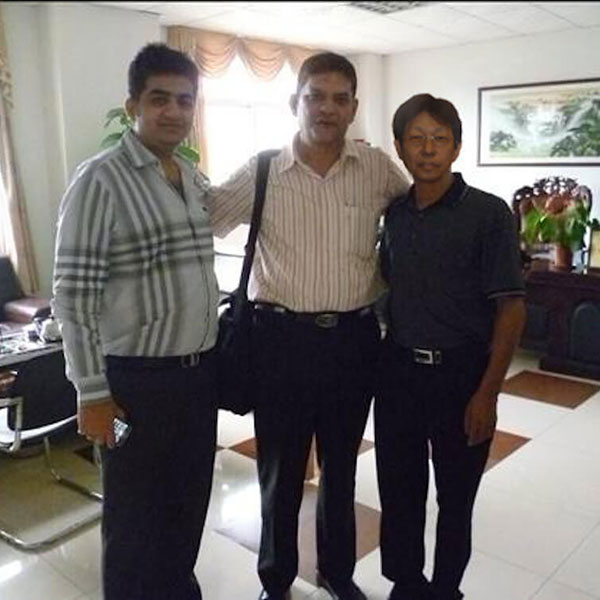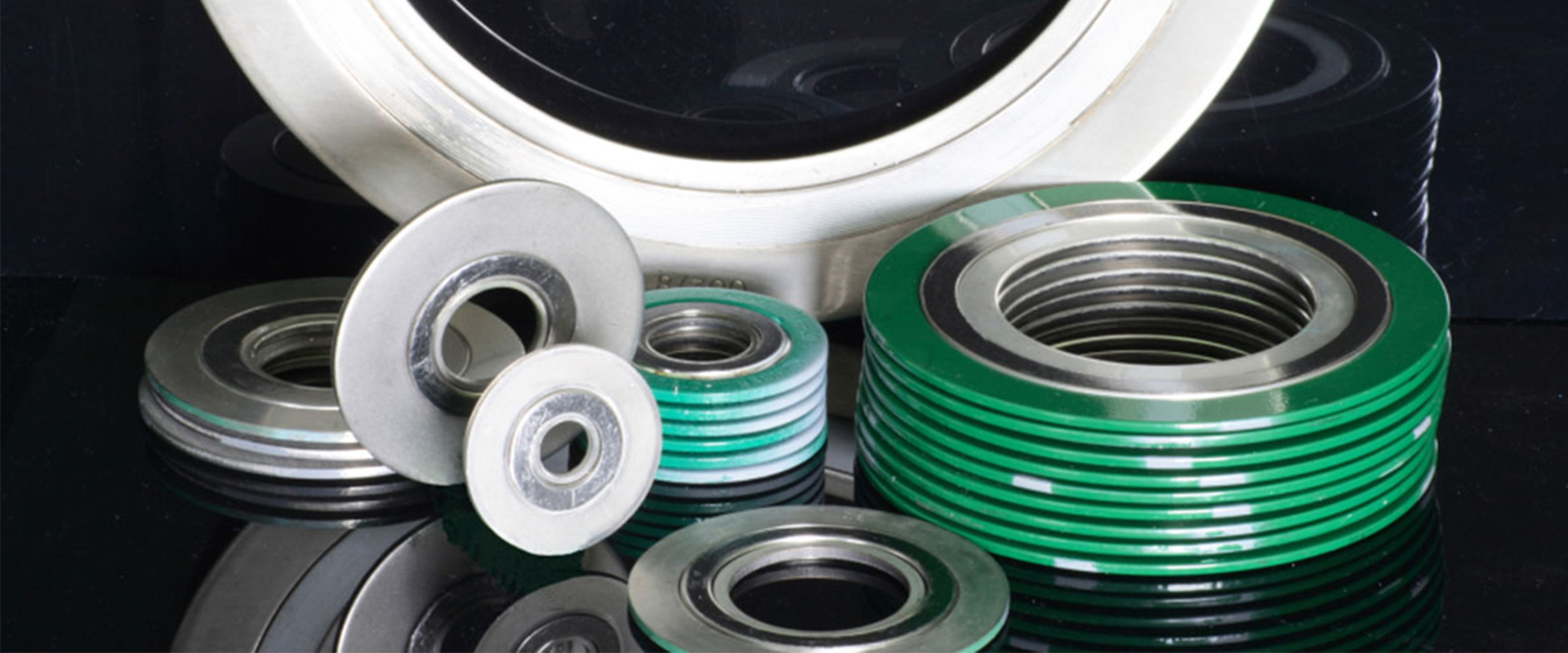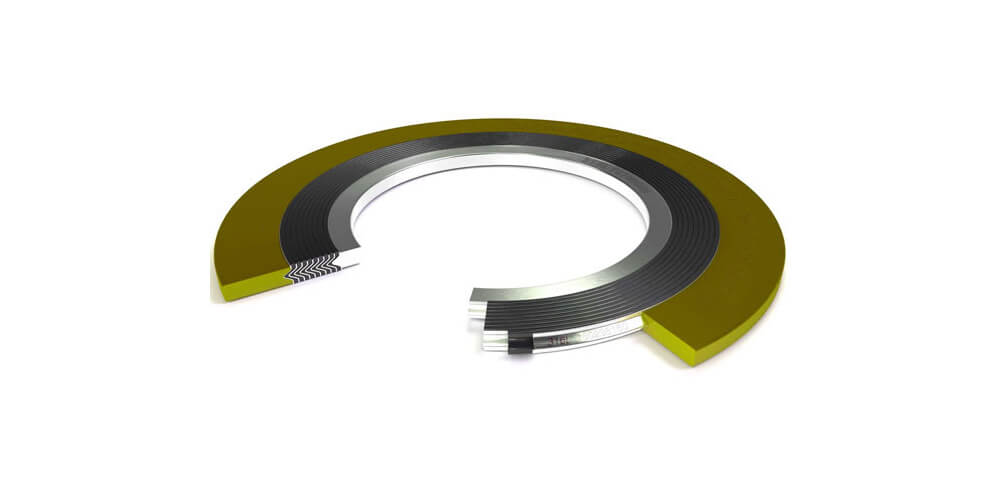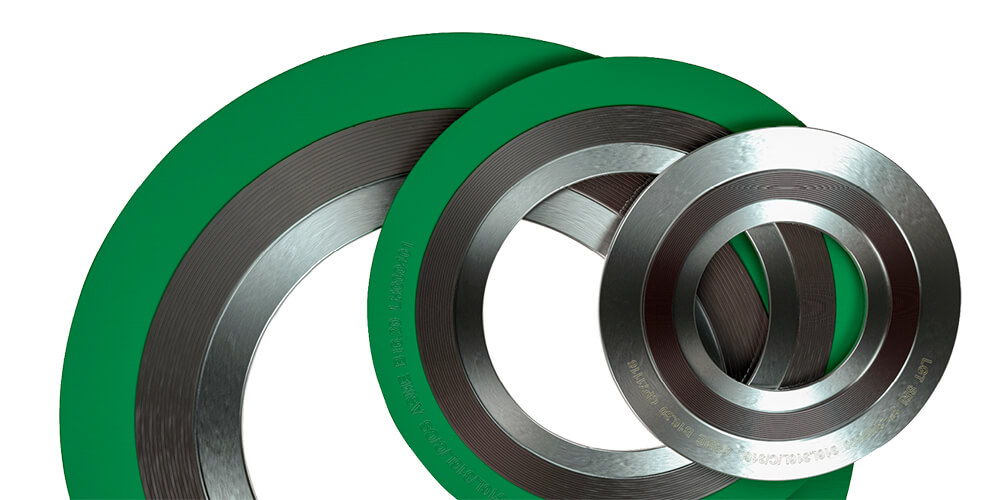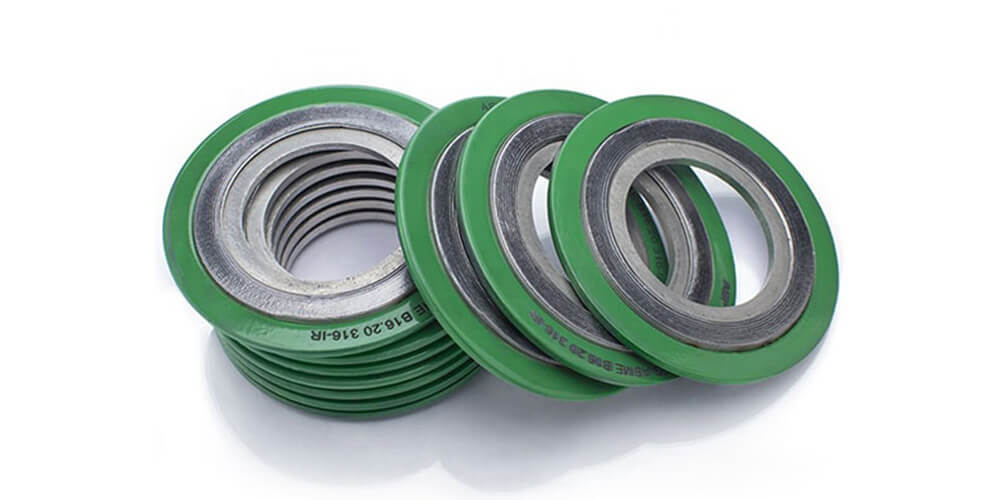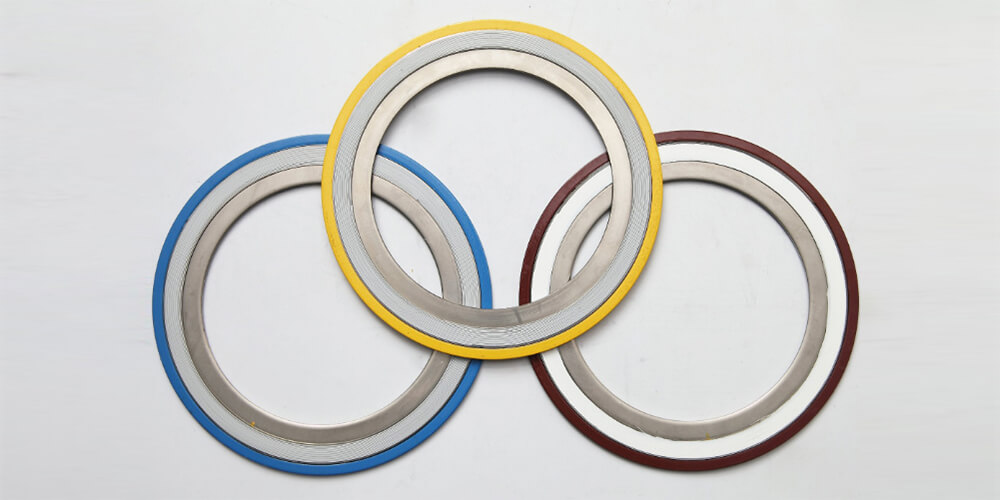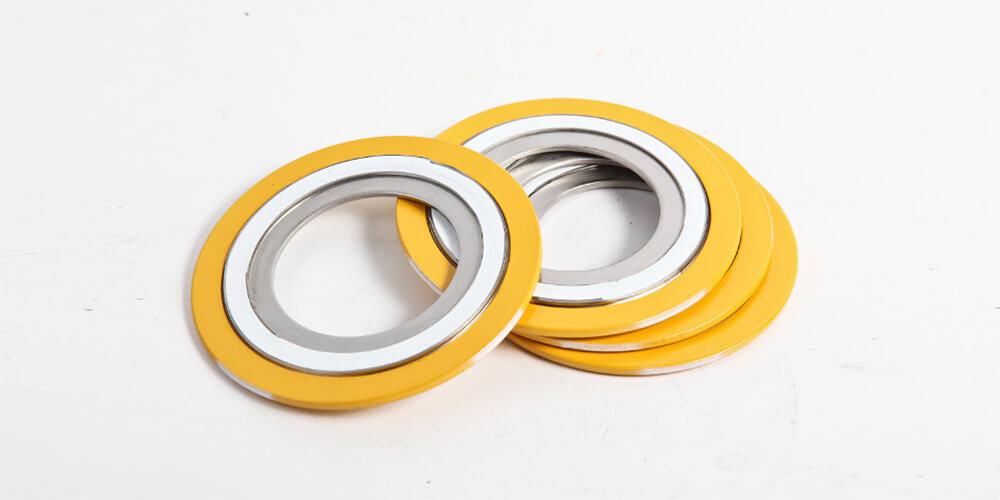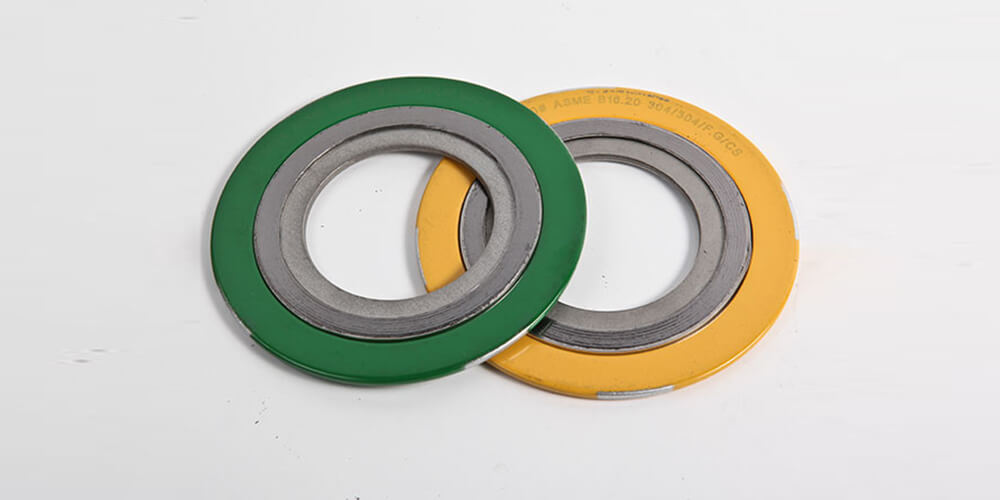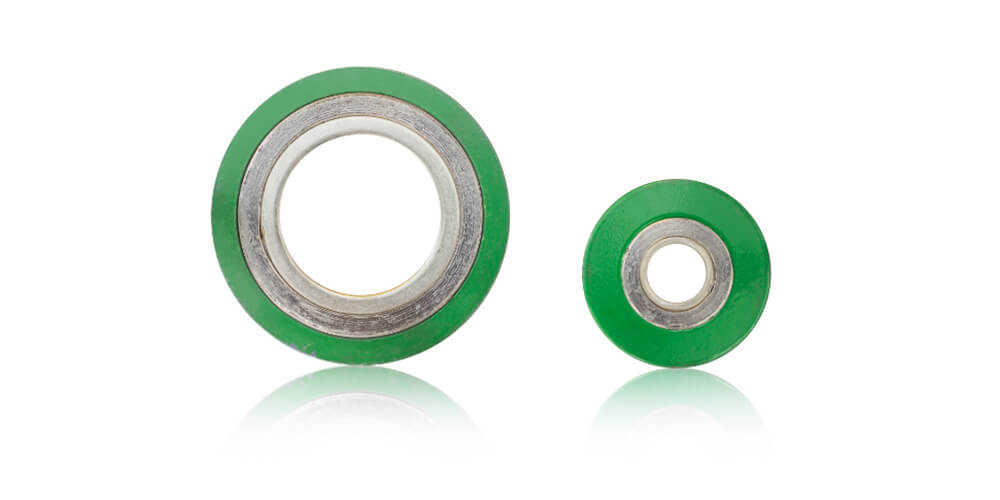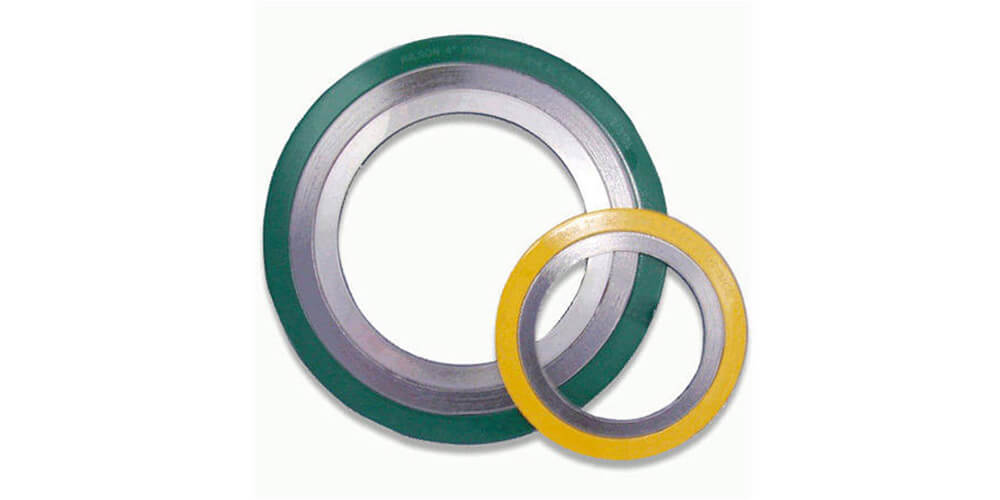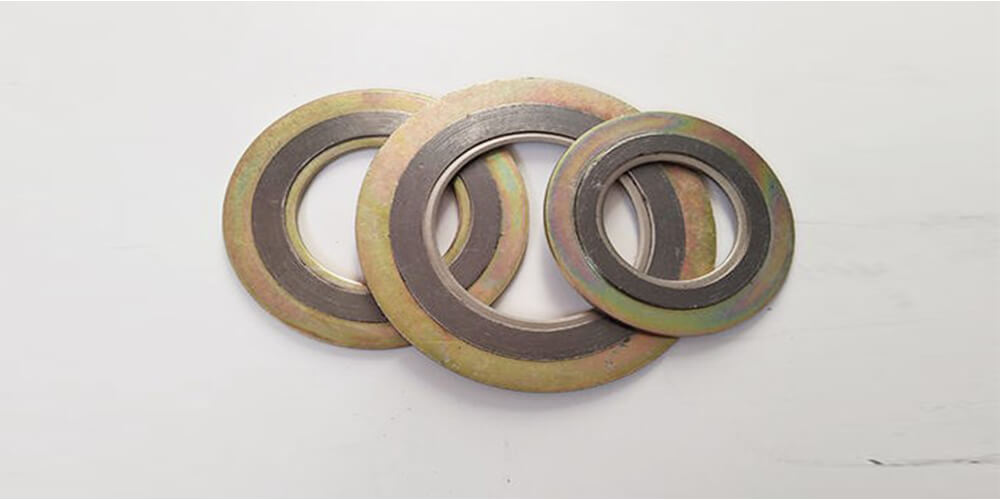Custom Spiral Wound Gasket
Spiral Wound Gasket (GS001) consists of the thin metal hoop and non-metallic filler material that is simultaneously wound. The metal hoop is pre-formed in V or W shaped profile, which allows the gasket to act as a spring between the flanges.
Spiral Wound Gaskets are extremely popular due to the wide variety of available styles and sizes, it is the precision-engineered solution for flange joints, manholes, and other high-temperature, high-pressure applications. We can produce according to ASME, BS, JIS, and EN(DIN) standards or client requests.
| Item | Style | Flange | For example |
| Basic type SWG | GS001 | Tongue and Groove | 304/PTFE |
| SWG with inner ring | GS001IR | Male and Female | 304 304/FG |
| SWG with the outer ring | GS001CR | Raised faceFlat face | 304/ASB CS |
| SWG with inner & outer rings | GS001IC | 304 304/FG CS | |
| SWG for heat exchanger | GS001H | Heat exchanger | 304/FG with 1 bar of DJ |
| Special shape SWG | GS001S | Special | Oval |
The gasket can be used as the static sealing element of pipe, valve, pump, thermal exchange, condensing tower, plain hole and man hole of flange, etc.
Petrochemical, chemical, mechanical manufacturer, power station, metallurgy, shipbuilding, medical and pharmaceutical unclear power station and navigation, etc.
Spiral Wound Gaskets Manufacturers FAQ
Spiral Wound Gaskets FAQ Guide
Spiral wound gaskets are widely used in the oil and gas industry, especially in high working pressure and critical applications. Spiral wound gaskets are made by spirally winding prefabricated metal sheets and fillers on the outer edge of a metal mandrel. The metal strip/wire (usually 304SS or 316SS) is wound outward in a circle, and the filling material (usual graphite) starts to wind in the opposite direction.
This leads to a growth cycle of alternating layers of filler material and metal tape. In addition to providing additional radial strength, the guide ring of the spiral wound gasket also acts as a compression stopper. The outer metal ring of the spiral wound gasket fixes the coil of the gasket in place, places the gasket between the flange bolts and aligns the sealing surface.
Here Bandak Sealing summarized the faq guide for spiral wound gasket:
1. What is a spiral wound gasket?
Spiral wound gaskets are gaskets in the form of a V-shaped metal strip with a soft filler material. Metal strips provide outstanding recovery, while flexible filling ensures an excellent seal. Material selection criteria for metal strips include fluid concentration, corrosion maturity, and operating temperature since the most commonly used materials include stainless steel 304, 316, and 321. The general materials used as fillers are graphite, ceramic paper, mica, asbestos, etc.; the outer center ring is made of carbon steel. Spiral wound gaskets are generally round, but also rectangular, oval, and diamond.
Due to this combination of materials, spiral wound gaskets are suitable for sealing under severely fluctuating temperature and pressure conditions. Depending on the application, spiral wound gaskets can be specified with outer and/or inner rings.
1) Stress
Corresponding to the flange pressure rating, spiral wound gaskets are available in 150, 300, 600, 900, 1500, and 2500 pressure ratings. The low-voltage level (I.E. 150#) adopts a low-density structure, and the number of metal windings per unit width is low. High-density applications require more flexible designs, and more metal windings per unit width must be added to the gasket design. Therefore, the datasheet does not exist to cover all variations of spiral wound gasket design.
2) Material
The material is determined by the color of the outer edge of the pad. The stripes along the outer edge represent fillers (graphite, polytetrafluoroethylene, etc.). MSI’s spiral wound gasket color table shows the outer edges and fillers of different material colors and gasket identification.
3) Inner ring
Spiral wound gaskets with an inner ring are common because the inner ring helps prevent so-called coiling. When pressure is applied during the bolt connection process, it may cause winding, causing the winding to unfold in the ID of the gasket, causing many problems. Pigging can also cause this problem when the pipeline is being cleaned.
4) Series A vs Series B
Large-diameter flanges (NPS 24″ and above) complying with ASME B16.47-Serie A or MSS-SP 44 standards are heavier/stronger than ASME B16.47-Series B under the same diameter and rated pressure. In most cases, The end user’s piping specifications all stipulate series A, which can bear more external loads than series B. The dimensions of these two series are different. From a commercial point of view, series B can be used for non-critical applications Pipeline.
5) Dimensional Data
Here are the dimensional data for the spiral wound gasket:
| NPS | d1 | d2 | ||||
| Class 150 | Class 300 | Class 400 | Class 600 | Class 900 | ||
| 1/2 | 21 | 48 | 54 | 54 | 54 | 64 |
| 3/4 | 27 | 57 | 67 | 67 | 67 | 70 |
| 1 | 33 | 67 | 73 | 73 | 73 | 79 |
| 1¼ | 42 | 76 | 83 | 83 | 83 | 89 |
| 1½ | 48 | 86 | 95 | 95 | 95 | 98 |
| 2 | 60 | 105 | 111 | 111 | 111 | 143 |
| 2½ | 73 | 124 | 130 | 130 | 130.2 | 165 |
| 3 | 89 | 137 | 149 | 149 | 149 | 168 |
| 3½ | 102 | 162 | 165 | 162 | 162 | … |
| 4 | 114 | 175 | 181 | 178 | 194 | 206 |
| 5 | 141 | 197 | 216 | 213 | 241 | 248 |
| 6 | 168 | 222 | 251 | 248 | 267 | 289 |
| 8 | 219 | 279 | 308 | 305 | 321 | 359 |
| 10 | 273 | 340 | 362 | 359 | 400 | 435 |
| 12 | 324 | 410 | 422 | 419 | 457 | 498 |
| 14 | 356 | 451 | 486 | 483 | 492 | 521 |
| 16 | 406 | 514 | 540 | 537 | 565 | 575 |
| 18 | 457 | 549 | 597 | 594 | 613 | 638 |
| 20 | 508 | 606 | 654 | 648 | 683 | 699 |
| 24 | 610 | 718 | 775 | 768 | 791 | 838 |
| NPS | d1 | Class 150 | Class 300 | Class 400 | Class 600 | Class 900 |
| d2 | ||||||
- d1 = inner diameter.
- d2 = outer diameter.
- Outer diameter NPS 12 and smaller tolerance: +0 / -1.5 mm.
- Outer diameter NPS 14 and above dimensional tolerance: +0 / -3.0 mm.
- Dimensional tolerance, inner diameter NPS 12 and smaller: ±1.5 mm.
- Dimensional tolerance, inner diameter NPS 14 and above: ±3.0 mm.
- Thickness (t) is specified by the customer
6) Chemical compatibility:
- Air, 200-300°F-Silicone
- Beer-EPDM
- Chlorine water-fluorine pass (FKM)
- Gasoline-Nitrile rubber or Fluorine rubber (FKM)
- Hydraulic oil (petroleum-based, industrial)-nitrile rubber
- Hydraulic oil (synthetic base)-Viton
- Water-EPDM
- Engine Lubricant-Nitrile Rubber
2. What is the structure of a spiral wound gasket?
A spiral wound gasket consists of three parts:
1) Outer ring
Made of carbon steel, this outer ring is sometimes called a centering ring or guide ring. It is used to center the gasket when you insert it into a bolted flange joint.
2) Inner ring
The inner ring is the key to the gasket as it prevents the windings from bending inside the pipe. When the gasket is fastened, part of it is drawn into the pipe. From there, fragments of the gasket usually flow through the pipe until they get caught in something. Often, they wrap around rotating equipment like a pump. The resulting mess is known as the “Bird’s Nest.” The Inner ring can help you avoid this problem.
3) Sealing element
As you might guess from the name, sealing elements create a seal that prevents leaks. A sealing element includes windings and filler material. In oil and gas refineries, most spiral wound gaskets will use a high-temperature-resistant flexible graphite filler material. The flexible graphite packing also allows the spiral wound gasket to be more forgiving of flange deformation and joint misalignment. Polytetrafluoroethylene (PTFE) is another common filler material. However, PTFE is not suitable for high-temperature applications. At the same time, most of the winding materials in the refinery are stainless steel.
3. What is the function of a spiral wound gasket?
When a flanged connection assembly is in use, three basic factors come into play and work together to affect the overall sealing capability of the connection: bolt force, hydrostatic end thrust, and radial pressure (blowout). Since these forces are dynamic manipulated variables, it is better to use an elastic structure than a solid building.
Spiral wound gaskets can be thought of as heavy-duty springs in series with bolts, nuts, washers, and flanges. Its spring-like structure allows the gasket to recover under variable loads. Seat stress forces packing into the flange defect, creating a seal. The flexible metal winding maintains hermetic integrity as the flange moves. And its spiral shape makes it easy to reduce the erosion and pressure caused by movement. In this way, machines installed with spiral wound gaskets are more able to withstand high pressure.
4. What are the advantages of spiral wound gaskets?
Due to its unique structure, a spiral wound gasket has many distinct advantages which make it possible for this type of gasket to be used in a wide range of industries. Below are some of its most obvious advantages.
- Of its ability to withstand high pressure, it can be used in pipes, valves, pumps, heat exchangers, etc.
- Gasketing, sealing, leak-proofing, installation, protection from environmental contaminants, and vibration damping are all functions of spiral wound gaskets.
- They can withstand high pressure, high temperature, and corrosive conditions, and they require less clamping force than solid gaskets.
- Due to their v-shaped design, these gaskets fill like a spring, making them suitable for a variety of working conditions.
- These gaskets also avoid gear failure and associated costs due to their reliability and robustness.
- Due to their V-shaped profile, these gaskets provide a spring-like cushion; therefore, are reliable in a variety of operating environments, and they are also fairly easy to install.
- Due to their reliability and strength, these gaskets also prevent gear failure and the following costs.
- The outer ring of the spiral wound gasket simplifies assembly and prevents the gasket from bursting.
- The inner ring prevents the radial flow of soft packing and reduces turbulence; thus reducing flow resistance.
- The inner ring also acts as a thermal barrier when the helically wound gasket is exposed to high temperatures.
- The center ring of the spiral wound gasket protects the spiral wound element and provides additional safety against the bursting of the gasket, along with the inner ring.
- The center ring also acts as a compression limiter, preventing overload and over-compression of the helically wound element.
5. What are the characteristics of spiral wound gaskets?
There are many features of spiral wound gaskets and these are the reasons why sometimes you need a spiral wound gasket over other types of gaskets.
- Edge sealing
Most gaskets are cut from sheets, which means they seal on a flat surface. When the flanges are not parallel, the gap between them varies, forcing the use of thicker materials. The smaller the gap, the greater the compression of the material. Soon, the material reaches its limits. In contrast, a spiral wound gasket seals on its edge rather than on a flat surface. To do this, a long thin piece of spacer material is rolled up to form a loop. Placed between the flanges, its edge strips make a seal.
- Built-in spring
To increase elastic recovery and ensure the seal remains sealed no matter how the joint moves, the gasket material is interwoven with the metal strips. During the winding process, the composite material forms an approximate “V”-shaped cross-section. The metal “V” acts like a spring, pushing the flange outward.
- Spiral wound gaskets usually have an inner metal core and an outer metal ring. These are thinner than coiled gasket materials, so limit how much the gasket can compress. The inner core also increases blowout resistance; one of the reasons this design works so well in high-pressure environments.
- For easy identification, the outer edge of each spiral wound gasket is color coded. These specifications follow American Society of Mechanical Engineers (ASME) standards and make it easy to identify and order replacement parts before disassembling the joint. This helps minimize downtime!
6. What materials can be used to make spiral wound gaskets?
The choice of gasket material is critical. Usually, spiral wound gaskets are made of Teflon or graphite, both of which are available in different grades. In addition, the choice of metal also takes into account the appropriate degree of elasticity as well as corrosion resistance and durability. Usually, stainless steel, alloy, and other strong materials would be selected to make the metal part.
7. How much does a spiral wound gasket cost?
Spiral wound gaskets typically range in price from a few dollars to dozens of dollars, depending on the diameter, material, and life of the spiral wound gasket.
8. When to use spiral wound gaskets?
Spiral wound gaskets are suitable for flanges with large temperature and pressure fluctuations. (environments that lengthen the bolt and lower the clamping pressure) In addition, when the non-metallic element is Teflon or graphite, these gaskets provide excellent chemical resistance. That’s why spiral wound gaskets are the gasket of choice for refineries and related petrochemical applications.
Spiral wound gaskets are also suitable for high-temperature and high-pressure conditions and corrosive media. That’s why they are the gasket of choice for many petrochemical plants, and their long life helps reduce downtime.
9. What do you need to know about spiral wound gaskets?
When you first get to know spiral wound gasket you might have some misconceptions about this type of gasket or know little about it. For the proper use of it, here are something that you need to make clear and some details you need to check out before installing it.
- The outer ring is not a compression brake.
While some manufacturers call the outer ring a compression brake, that’s not actually the case. If your gasket has enough seating stress to compress to the outer ring, you basically have a flat metal gasket that gives you little or no recovery when your factory loop and flange faces are separated due to thermal expansion.
- The flange face does not fall flat on the sealing element as most people think.
The flange face will actually rotate a bit. What does rotation mean? If you look at the convex surface the convex surface is actually the pivot point of the lever. The end of the lever is where the nuts actually clamp together. So all you have to do is turn your flange, that is, turn the flange “beak” a bit. Now they should be equal beaks, but sometimes they don’t. One face of the flange is usually curved to the other.
This creates what we call a “swing plate”. Some people call it cupping, but the technical term is cupping. That is when the outer ring bends. There are many conspiracy theories about this. Some people will say, “Oh, it’s going to get stuck with the threads.” That’s not the case. Because the flange is rotated, it may be rotated 1 to 2 degrees. It depends on the length of your outer ring, which determines how much deflection you see at the end of it.
- Take care of the gasket correctly
Make sure the bolt and nut threads are thoroughly cleaned. Often lubricate the bolt and nut threads and make sure the surfaces of the nuts are tightened. Do not apply grease or bolt lubricant to the joint faces. After cleaning and lubricating, it should be possible to run the nut along the entire length of the bolt by hand. If this is not possible, bolts and nuts should be refurbished or replaced. If necessary, use a wire brush or file to scrape the back of each bolt head and nut mounting flange to ensure a clean, flat surface. If possible, use hardened flat washers to ensure even load transfer.
If the gasket is required to be secured to the flange prior to assembly (such as large vertical flanges), a light spray adhesive such as 3M 77 Spray can be used. Adhesives should be used in small quantities in isolated areas and must be compatible with fluid media.
10. What you should take care of when installing spiral wound gaskets?
It is essential for you to know how to install a spiral wound gasket on your own. The following list is only a basic overview and should not be considered formal advice or instructions. Consult your gasket manufacturer.
- Gaskets are always new
It is very important to only use a new gasket. Make sure the gaskets are in good condition, the size is usually the grade and size of the flange, and do not use compounds, oils, or lubricants that interface with metal gasket elements. These materials can affect the contact friction between the gasket and the flange, leading to creep and premature joint failure
- When installing gaskets on new flanges or replacing old flanges, the flange surfaces should be clean and free of indentations and scratches. Cross-face scratches are a major problem as this can lead to leaking joints.
- When scoring appears, the flange surface can be reworked using a portable machine tool such as a Mirage flange planer. Gasket manufacturers recommend a surface finish between 3.2 – 6.3µ. A surface comparator is a useful tool for checking the finish.
- Flange faces should be parallel and concentric, and there is no need to pull them into place when the bolts are overloaded.
- Make sure the flanges are in good condition
It is necessary to check that the flange surface is clean and completely free of dents and scratches. Radial (cross-face) scratches are actually a special problem that can lead to leaking joints. For spiral wound gaskets, a surface finish between 3.2 μm and 6.3 μm Ra (125 to 250-micron inches) is required. Use the Surface Comparator to view flange surfaces. Make sure the flange faces are parallel, or the pipe actually has enough adaptability to allow the flanges to be dragged parallel and concentrically without extreme bolt loads.
- Before installation, inspect whether the gasket is safe to be used and meets the correct specifications required.
- Check whether the flange faces are parallel after installation. This can be achieved with a flange clearance measuring tool.
11. Can you reuse spiral wound gaskets?
The spiral wound gaskets are usually not recommended to be reused but they might be reused under some specific circumstances.
1) Conditions under which a spiral wound gasket may be reused
Gaskets may be suitable for reuse if:
- Gaskets are not exposed to extreme heat.
- The gasket is not exposed or swollen or exposed to fluids.
- Gasket thickness remains unchanged, with high compressibility and strong sealing.
2) Reasons why gaskets should not be reused
- If the gasket has dried out, is brittle, hard, etc, it is not recommended to be reused. Ultimately, this gasket will not function as well as a new one.
- If the gasket swells due to extreme contact with liquid. In these cases, you should not reuse the gasket due to the over-saturation of the gasket.
- The final reason for not reusing gaskets comes down to compressibility. A gasket works best when it can achieve a great first seal with initial compression.
In all cases, gaskets should be properly designed and installed if you want them to perform at their best. And as manufacturers, we always recommend replacing old spiral wound gaskets with new ones to keep your application safe and continue to maintain high-performance levels.
12. How to check the quality of your spiral wound gaskets
It is important to check the quality of a spiral wound gasket before using it. Here are some basic steps and procedures you need to go through.
- Check that the gasket material is marked with style and brand
- Know the operating range of the gasket (check temperature and pressure ratings)
- Evaluatespiral wound gasket flexibility based on filler material
- Check the production date code for age and lot number
- Remember, Cheaper Doesn’t Mean Better
- Clarify the correct gasket for your application
- For easy identification, spiral wound gaskets will be color coded and stamped to ensure this is visible on the gasket.
13. How to store spiral wound gaskets?
A basic guideline for most gasket manufacturers is to store gasket material in a cool, dry place away from heat, excessive humidity, direct sunlight, and chemicals. Optimal storage conditions require between 4 – 27°C, 40% – 75% relative humidity, in a room with no windows and no UV or low UV-producing lights, minimal dust, and no nearby chemical storage.
1) What do you need to know about spiral wound gasket storage?
Gaskets storage areas are often located near large receiving doors, are illuminated by fluorescent lights, and are subject to frequent fluctuations in temperature and humidity. Heavy metal spacers are usually stacked on shelves, and soft spacers are usually stored on pegboards hung on the wall. Sheet materials are sometimes stored on open shelves, partially rolled up in corners, or along walls. The optimal storage method has a significant impact on the shelf life of the gasket. The time from production to when the quality/performance of the product becomes unacceptable is called shelf life. The shelf life of a product is affected by the composition of the product and the environment in which the product is exposed to manufacture distribution and storage.
Gasket materials are often stored for months, sometimes years, before use. Their shelf life is an important piece of information for users. Metal materials, semi-metal materials, graphite materials, and PTFE materials are not greatly affected by storage time, and if stored correctly, they can be stored on the shelf for more than 10 years without degradation. Some manufacturers even state an infinite shelf life for their products. While these products are not susceptible to adverse storage conditions, it must be considered that excessive dust can fall on them and cause compatibility issues with the media being sealed. High humidity and moisture can also cause metal components to oxidize, and over time the adhesive loses its ability to bond. These materials are easy, however, for sheet joining and cutting gaskets, using elastomer-bonded material as a base will make sure that the spiral wound gasket receives the basic protection it needed.
14. What are the marks on the spiral wound gasket?
Spiral wound gaskets are distinguished by various markings on the gasket. Each mark provides precise details about the spiral wound gasket specification, which aids in the gasket selection process.
The markings on the spiral wound gaskets provide the following basic information:
- Design Standards or Specifications: Displays the specifications used to design and produce spiral wound gaskets. Standard ASME B16.20 is easy to see with this gasket.
- Manufacturer information on spiral wound gaskets: The manufacturer of the gasket can be easily identified by checking the manufacturer’s name on the gasket.
- Winding and filling materials: Spiral wound gaskets specify winding and filling materials.
- Diameter and pressure rating: The diameter and pressure rating markings on the gasket indicate the size of the gasket and the load that the wound gasket can withstand. Pressure ratings for spiral wound gaskets are typically 150, 300, 400, 600, 900, 1500, and 2500. The ability of spiral wound gaskets to withstand pressure increases with the increase in pressure rating.
15. What are the differences between spiral wound gaskets and sheet gaskets?
Gaskets, in their simplest form, are when a sheet of material has a gasket shape “punched” out. Manufactured materials can be made in different grades and thicknesses, and materials used include rubber, paper, cork, non-asbestos materials, and graphite.
Alternatively, spiral wound gaskets are constructed by winding a metal and filler together, with the filler providing the sealing ability and the metal providing the strength. Normally a spiral wound gasket manufacturer can provide you with spiral wound gaskets and sheet gaskets, as well as custom gasket materials if a more customized approach is required.
16. Which type of gasket is the best?
It all depends on what the gasket is for and how it ends up being used. Gaskets and spiral wound gaskets play a vital role in many different products, most importantly in several different industry sectors as well. Back to the basics, the final gasket is the thin ring that acts as a seal between the two surfaces. Helps with filling, leak prevention, installation, vibration damping, and, in some cases, most importantly, helps protect the environment from contamination.
Due to their various uses, choosing the right gasket is critical. Knowing the difference between spiral wound gaskets and sheet gaskets is of great necessity. Usually, the team of gasket experts is on hand for information and advice, and the manufacturer can provide the best technical help and support.


